#mythic xenofiction
Text
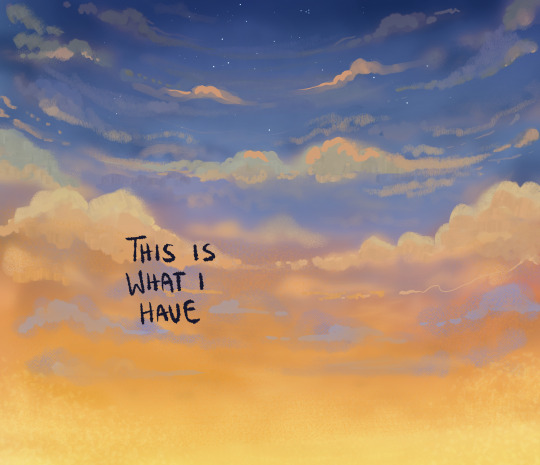

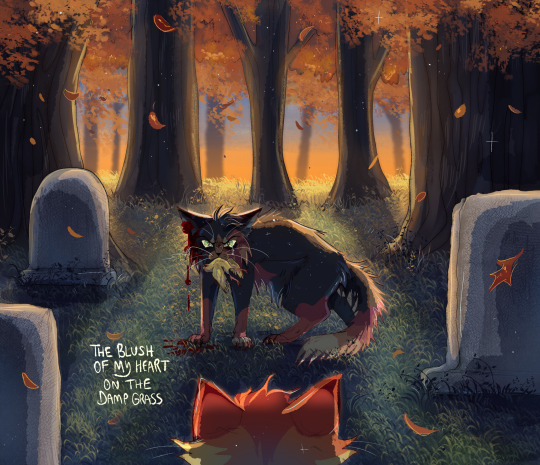
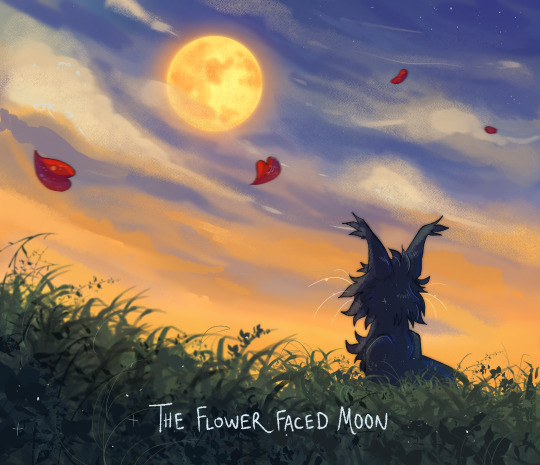
little crazy love song — mary oliver
#moth bethel#splinter bethel#honey bethel#rook rosen#cat ocs#animal xenofiction#mythic xenofiction#this is kinda. a peak at the very beginning of cathedral#where each mc starts out
566 notes
·
View notes
Text

Fanart of Storm from Hunters Unlucky. Listened to the 4hr audiobook sample and its SO good. Stayed up super late to listen to it all (at least that fixed my sleep schedule lol)
Character belongs to @alhilton
Eye detail below cut

#hunters unlucky#storm Ela-ferry#hunters unlucky storm#abigail hilton#xenofiction#mythic xenofiction#itsskoll thoughts#gotta buy the full thing when i get paid next#or get another comm lmao#ferryshaft#cant believe i forgor that tag
31 notes
·
View notes
Text
youtube
youtube
If you guys have an hour or two to kill, I highly recommend these two videos by Cardinal West on the Xenofiction genre. I have a far greater appreciation and understanding of the genre and it’s sub-categories thanks to him and his videos. These and his other xenofiction video essays are all so well written and entertaining and such a great resource for people wanting to get into reading or writing the genre.
#xenofiction#writing#literature#animal fantasy#animal fiction#naturalist xenofiction#mythic xenofiction#genre#fantasy#speculative fiction#video essays#long video#long video essays#worldbuilding#animals#animal society#animal societies#xenofiction literature#xenofic#cardinal west#Youtube
69 notes
·
View notes
Photo
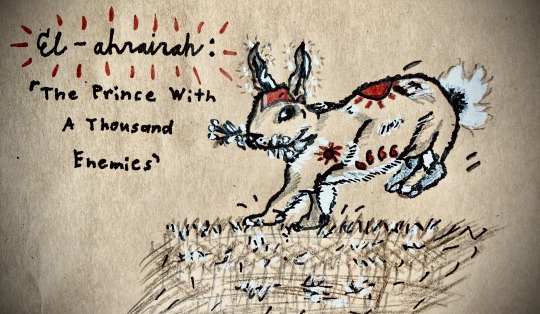
El-ahrairah
from Watership Down, by Richard Adams - “The Story of El-ahrairah and the Black Rabbit of Inlé” (I like his description when he gets his tail replaced with clematis and his whiskers with ragwort, then later dock leaves for his ears.)
Medium: Pen and Ink, Graphite, Marker, and Paint; on Paper
#el-ahrairah#watership down#richard adams#xenofiction#mythic xenofiction#art#rabbit#sketch#drawing#concept art#frith#black rabbit of inlé#myth
25 notes
·
View notes
Text

The Beasts Bloom🥀🐅
By:
https://www.deviantart.com/polawat/gallery
#fantasy#digital art#digital painting#deviantart#fantasy art#mythical beasts#xenobiology#xenofiction#aesthetic
37 notes
·
View notes
Text
Fins Above: FLIGHT is in it's final stages! I wanted to let you all know before the final book in the arc is put into late drafts and is published, that if you could support me in making Xenofiction in any way possible - thay would be lovely!
I am not opposed to animal xenofiction, but one day I do wish that I could make a series or book dedicated to cats/dogs/or even snakes! But right now, my beast xenofiction has influenced so much of my character and writing that I want to see where this goes before I start on animal xenofiction.
I am grateful for anyone following or supporting me already, you have done so well in helping me by purchasing my books or even sharing these posts. I have come a long way and I am proud of myself for even picking up that old Fins Above draft in the first place. If not, none of this would have happened.
I am deeply grateful.
Now, we are on the final book of The Blue Flame arc, and I will be soon to announce the new arc after everything is done and the cover is finished! Please, if you can, and haven't already, purchase one of the books or share one of the free Fins Above content to friends and family !

#illustration#artists on tumblr#digital artist#illustrator#writer#xenofiction#fins above#animal fiction#merfolk#mermaid#mermay 2024#book#books#self published#ya books#ya fantasy#fantasy#mythical creatures#magical creatures#fantasy world#worldbuild#worldbuilding#fiction#beast xenofiction#bookblr#books and reading
6 notes
·
View notes
Text
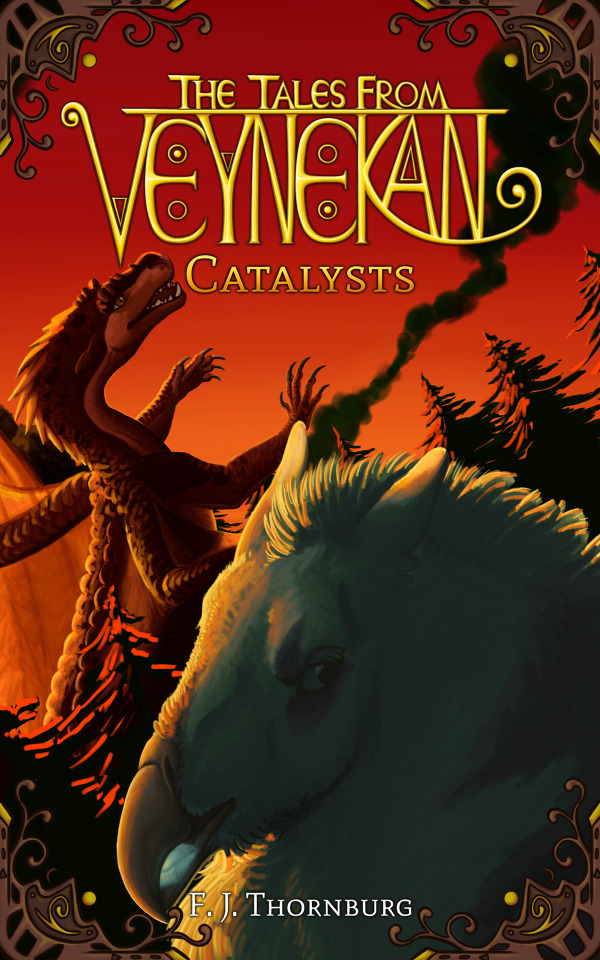
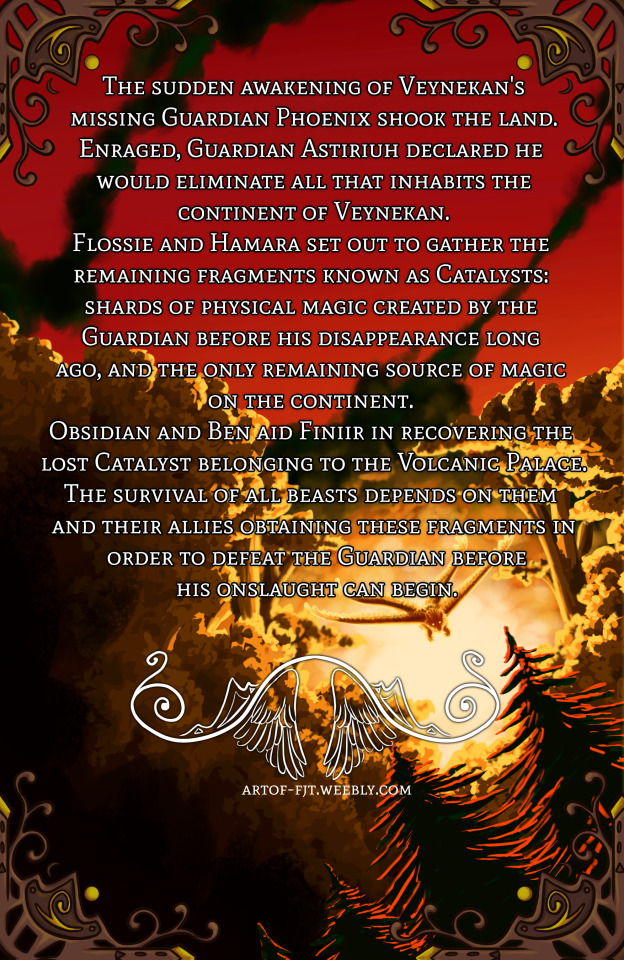
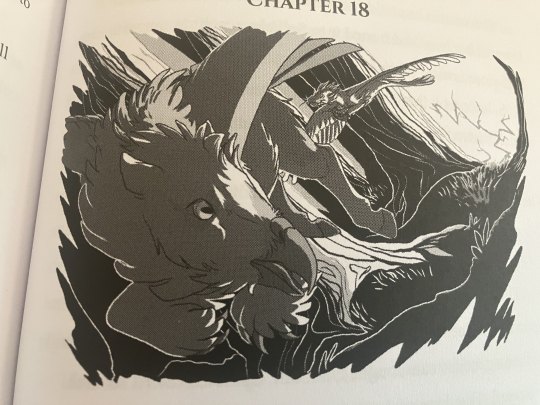
The Tales From Veynekan Book #2: Catalysts has been released in eBook and paperback!
It is a direct continuation of book #1: The Flaming Queen
The Tales From Veynekan is my fantasy xenofiction series following mythical animals and their battles to live on despite the continent becoming forsaken in the eyes of their own Guardian.
"The sudden awakening of Veynekan's missing Guardian Phoenix shook the land. Enraged, Guardian Astiriuh declared he would eliminate all inhabits on the continent of Veynekan.
Flossie and Hamara set out to gather the remaining fragments known as Catalysts: shards of physical magic created by the Guardian before his disappearance long ago.
The survival of all beasts depends on them and their allies obtaining these fragments in order to defeat the Guardian before his onslaught can begin."
#the tales from veynekan#independent author#xenofiction#fantasy#book series#ttfv catalysts#dragon#hippogriff#griffon#book cover#illustration#lgbt books#nigelpuppy
52 notes
·
View notes
Note
I don’t read a lot of xenofiction. Is eugenics common in those stories?
I don't know if it's common per say, but it shows up way more than you'd expect for stories about talking animals. It's most commonly in the background or shows up in the world-building/other indirect ways (like beliefs based in eugenics just being casually mentioned in conversation) of a lot of stuff, usually in ways that are unnecessary and can be easily cut out/avoided with little to no impact to the wider story. It could just be because I read more of it, but it seems especially common in mythic xenofiction in particular (stories from the perspective of magical/mythical creatures like dragons, or regular xenofiction where magic is part of the world).
There's a few stories I know of where it's a big part of the plot or a character's backstory, but weirdly enough, I don't mind that as much, because there's a reason for it to be there. it's not just "ableism/racism for world-building flavor" - it serves a purpose. Not to mention, it almost always ends up showing the flaws in that way of thinking and showing how those ideas lead to more harm than good - even in the context of animals.
14 notes
·
View notes
Text
Clowder Info — The Basics

There are three cat clowders residing on the outskirts of an abandoned lake town. They formed 40+ years ago through various house and farm cats left to their own devices after humans disappeared from the area. The clowders are organized and similar to small communities.
Each group has their own last name, but this doesn’t mean every individual in one clowder is related. The “surname” is to differentiate them from each other. There are the Rosens (the flower-loving barn cats), the Bethels (the strange church cats), and the Darrows (the serious hunting shack cats). The clowders appear to be the only intact colonies in their area.
The clowders are known for taking in wanderers down on their luck. They’re safe spaces for cats to stay for the rest of their lives or only a short while. The Darrows are an exception and they’re not as receptive to having strangers among them.
These cats are semi-anthropomorphized in their lifestyle. They have their own written language, traditions, and many other traditionally “human” concepts. Occasionally a northern cat will venture into the clowders’ territories and voice confusion about their behaviors. This implies the clowders’ anthropomorphism is somewhat unique to them and the cats in the area.
ART
The clowders love art — be it music, storytelling, or painting/drawing. They use pieces of bark and slate to produce most of their art. Birch bark in particular is a favorite due to its lighter color. Paint is sourced naturally from crushed berries, clay deposits, blood, and ground-up leaves.
Rosen art consists of bright, vibrant colors and an adoration for whimsy. The inspiration lies in nature and the romanticism of life itself. Rosen cats teach their children art from a very young age and it is engrained in their way of life. They’re the “loudest” clowder in that the other two can hear them singing all throughout the day and night.
Bethel art, aesthetically, is the opposite. Their colors are muted and earthy, and their songs are on the morbid side. Bethels have a strong fascination with death and what comes after it. A notable tune from the Bethels is a ditty about our infamous serial killer, Darcy Darrow. It’s become so popular that it’s extended to Rosen youth and beyond the clowders themselves.
Darcy Darrow, Darcy Darrow,
has the voice of a field sparrow
She’ll skip you in the lake like a stone and
strip you down to meat and bone
Darcy Darrow, Darcy Darrow,
has the voice of a field sparrow
She’ll steal you at third hour dark and
peel your skin like birch bark
Despite its popularity, it’s garnered strong criticism from older cats who experienced the murders firsthand. Most of the youngsters simply can’t comprehend Darcy’s devastation because it didn’t affect them.
Darrow art often refers to or depicts winter. Snow is a religious symbol, a merging of heaven with the earth. There’s a haunting quality to the Darrows’ creations, coming off more unsettling than holy to some. The Darrows encourage their cats to sing and paint for their god and rarely anything else. Art functions as prayer.
ROLES
There are a handful of roles cats can fall into. These roles serve to better the quality of life within the clowder, and most require extensive training and work.
Head cat — The head cat is a leader and a role model. They are in charge of ensuring the safety of the vulnerable and settling conflicts with outside colonies as well as wanderers. The head cat is in their position for ~three years before a new one is chosen by popular vote.
Physician — These cats are in charge of tending to the sick and injured. They gather useful resources from the town, such as gauze, adhesive tape, disinfectants, and small tools. They hold a bi-monthly healing lesson for all the cats in case of emergency. Throughout the years they have attempted surgical procedures, however these always end fatally.
Flora — Often working directly with the doctor, the flora is a cat with vast environmental/plant knowledge. They’re in charge of plant safety, informing cats what is and isn’t safe to use or eat. They gather plants with medicinal properties to give to the physician. Occasionally a single cat can be both the physician and the flora if they’re skilled enough.
Fauna — This cat is knowledgeable of other animals and their behaviors. They are able to communicate with other carnivores and social groups such as the wild dogs. When there’s a rare territorial or food dispute, they clear up the situation by serving as a translator. The fauna tends to have many friends across multiple carnivora. Corvids are excellent communicators, however due to the biological differences in vocal cords they must use body language and mimicry to convey their thoughts.
Scribe — The scribe is a history buff and a talented writer. They are in charge of historical records, books, and other writings. They hold literacy and spelling classes, and they are often the sole cats spearheading attempts to translate human words. Modern day scribes are very interested in what became of humans and they've dedicated their free time to research.
Gatherer — This cat will go deep into the forests or town to search for items. These can be used for practical reasons (such as bedding), decoration, or to trade with other clowders. These consist of “furniture,” bones, human scraps, or anything interesting/useful the cat can find. Gatherers can be gone for up to a week, departing with a bag in which to stuff their discoveries.
Members — Cats of any age who have no particular rank. Some are hoping to be head cat one day while others are content doing their own thing. Members are either former wanderers or the children of cats who’ve resided in the clowder for years. All members no matter their age participate in classes taught by the important clowder cats.
The Kindle — All nursing parents and their kittens. Everyone pitches in to help the Kindle and it’s required that as much food gets to them as possible. Kindle beds are well-protected and made up of old blankets, feathers, and wool.
TERMINOLOGY/SLANG
Clowder: A group of cats, specifically used for the lake cats.
Colony: General term for a group of cats.
Crick: A small stream.
Day-legs: Unusually active during midday. “I see you got the day-legs. Go back to sleep.”
Draping: Placing your tail on another cat’s back comfortingly.
Flower folk: Nickname for the Rosens, can be used as an insult.
Glaring: A group of cats who don’t trust each other or a group of highly aggressive/territorial cats.
Old yawler: An elderly or middle-aged cat, used as an insult by younger cats.
Outsiders: Derogatory version of wanderer.
Rhuner: A devout follower of ‘Rhune,’ the feline god. Used as an insult against the Darrows or any extremely religious individual.
Stare-scratcher: A cat who makes direct eye contact to start a fight or argument.
Stone-skipper: A cat with high energy.
Tail-twined: In a committed romantic relationship. “Sorry, my tail’s already twined.”
Triller: A very talkative cat.
Up in my whiskers: Being nagged or annoyed, especially by a cat who ignores personal space. “He’s been up in my whiskers all day.”
Wanderers: Cats without a colony.
Lunar cycle: Another term for a month.
First/second/third/etc. hour dark: The hours after the sun sets.
Shroomhead: An insult, used as a substitute for ‘dumbass’ by young cats (think ‘crap’ vs. ‘shit’).
#info#*dies a hundred times*#cat ocs#mythic xenofiction#cat xenofiction#Embellishments to be added lol
210 notes
·
View notes
Text
You know what? There really is a little problem with the term "xenofiction" and that is that it is a genre with very ambiguous conditions.
Basically the only condition is that the protagonist is not human, so you have too many examples that would fall into the same category even though at first glance they look almost nothing alike. That's why some don't count it as a valid genre.
(As someone mentioned in some post SpongeBob is xenofiction and with that Cars would be too. And so on).
And as I've noticed, the vast majority of us tend to relate this "genre" to exclusively animal stories. Even though as I mentioned, this is not the case.
Besides, even with this description, it is still something very varied. Since there are many stories with different themes but with animals as protagonists.
So I decided to make a short list of the most appropriate qualifications I find for this "genre". It should be noted that this is only based on my subjective opinion of how it would be, so you are free to use this interpretation or use your own.
So let's call all this "Animal Stories" (For lack of a better proper name). And I would classify it like this:
-Animal Non-fiction: stories that use a real-life element as a basis, and explain it fully as it happened. Most of them have an academic objective.
This would include things like nature documentaries or educational books.
-Informative content: These ones provide information about the biology and basic behavior of the animal, without treating it as a story.
Like for example the scientific papers or books about the research of the species.
-Stories: Here real facts are narrated without any great liberty. Such as the history of hunting, disappearance, etc. of a certain species.
Like, the history of its conservation, biography of some famous real animal, etc.
Or more personal facts such as the experiences of naturalists, biologists or veterinarians during their daily work/life dealing with various species. A good example would be most documentaries.
-Animal Fiction: Stories that although they may be based on real elements, their story, characters, events and others were created by the author.
And this group includes:
-Animal Fantasy: Stories that are notable for having highly humanized and anthropomorphic animals. Being that they possess thinking, intelligence and very human attitudes. And features such as the use of clothing, complex tools, etc. In addition to that they can include topics such as magic and other things of a fantastic nature as something very relevant within their world.
On this group enters the two categories:
-Realistic Animal Fantasy: Here we find stories that, despite containing the aforementioned, still try very vaguely to respect the real biological characteristics of the species represented. In addition to limiting in certain aspects their abilities and thoughts to make them a little more "natural". You can also include stories that have mythological animals as protagonists, such as griffins, dragons, etc. with the detail of trying to represent them as more "naturalistic" and less fantastic animals.
-Mythic animal fantasy: Stories featuring both real and mythological animals that almost completely ignore their biological characteristics in order to make them more humanized, almost without any limits. Sometimes to the point of making them live in societies virtually identical to our own.
Realistic Animal Fiction: these are stories that try to show animals behaving in ways closer to how they would in real life, with little or no anthropomorphization. They may include certain liberties, but always approaching a higher level of realism.
And in this are the two categories of:
Naturalistic Animal Fiction: Stories featuring vaguely or non-anthropomorphic animals. Sometimes they do not even show the use of speech, being described by the author based on actions, sounds, actions or others. At the same time, their thoughts and abilities are limited according to the real knowledge of the species depicted, trying to stay as close as possible to how they would act in real life.
Mythical Animal Fiction: These are stories that feature animals that, although not be entirely anthropomorphized, have the ability to have societies, morality and other more sapient characteristics. They are still based on and limited to their respective biologies. In these stories magical elements such as supernatural entities or abilities can also be present, however, they are much less explored and are more of a secondary element. Because even with this, the world presented and the species used still feel almost identical to our own. (I thought that here could also enter stories that are based on fictional beings but are more based on real biology with almost no magic, although I'm not sure.)
Extra: And I didn't include this because I don't want to get too far ahead of myself, but also somewhere in there would be stories told from the point of view of other real living beings, not animals. Like plants, fungi, bacteria, etc, which like realistic fiction focus on accurately representing the real biology of these species with little or no humanization.
And I think that would be it. If anyone considers making any clarifications or changes to this idea feel welcome :).
#xenofiction#animal fantasy#animal fiction#dumb dumb ideas#idk maybe its incomplete or something but i guess its understandable#talking animal stories#animal stories#animal storytelling
19 notes
·
View notes
Text
#watership down#warrior cats#tumblr polls#poll#literature#books#Xenofiction#animal xenofiction#animal fiction#moralist xenofiction#realist xenofiction#mythic xenofiction
34 notes
·
View notes
Text
thinking back on how i've described my therianthropy as being like critters from animal xenofiction; both naturalist and mythic.
animals of farthing wood, watership down, redwall, felidae, wolf's rain, guardians of ga'hoole.
i WILL write something about this Eventually, i just need to find the time & words for it lol
4 notes
·
View notes
Note
Alright tumblr mobile isn’t showing me anything I type hope this is legible.
With writing stories featuring animals it isn’t a bad thing for your novel to have animals that appeared in a completely unrelated book. Like how many books feature wolves as the protagonist or cats? Go crazy go wills go crazy. Make a world that you imagine these animals would live in.
But if you two had to write a book with an animal that wasn’t cats (or dogs I guess now with survivors) which animal would you pick? Especially in a unique setting.
DULLARD: I do have a setting dedicated to prey animals found in redwood forests, but that covers a lot of creatures (mice, bats, birds, salamanders, skinks, etc). If I had to pick a specific one? Probably something in the amphibian family: frog, toad, newt, etc (if not all of them at once). I have more fun with the concepts I have for them in the redwoods than most of the other animals. If I was to go more typical, I do have a faint idea for a crow-based story, but I think the amphibians would be more interesting.
LYNX: Aww hell yeah! I've been working on a few other xenofiction side-projects (that are very barebones atm), some with mythical creatures, some with real-world species.
With the mythical creatures, I have a few, but the main one I'm fixated on right now has unicorns, drakes, and wingless gryphons all sharing a world together. It's not our world, obviously.
With real-world creatures, I have a more anthropomorphic xenofiction concept planned, though it's not like, furries, it's more like Guardians of Ga'Hoole and The Named where the creatures are still physically similar to what they are, they just use tools now, and it's a Ghibli-esque post-apocalyptic setting with sapient crows, rats, and mice.
Regarding naturalist xenofiction (ie, physically animal and can't use tools in a non-realistic manner), I don't really know. I haven't thought to try anything besides cats.
15 notes
·
View notes
Text
Salt Merfolk "study" sketch.
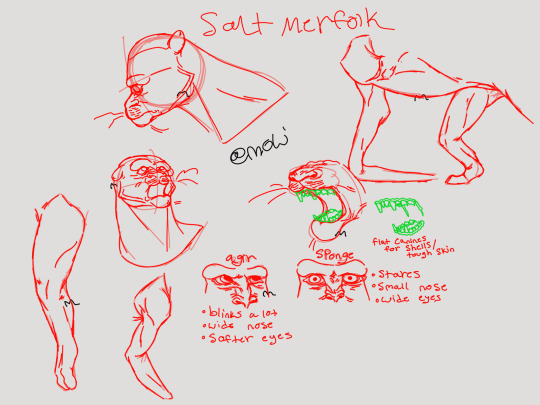
Bodies are strange but they're also fun to draw when it comes to fictional species. Mefolk in Fins Above specifically are different from the folklore humans made because I did not want to make them human outside of their concepts and society brought by their cousin species, the sirens. I did not want the humans to see these creatures and simply say- "theyre half human, so they matter."
I wanted to make the humans see them and say- "they look human, lets turn them into humanity." They force these creatures to be human so that humans can gain all of their advantages in the ocean. NASA was exploring the ocean for some time, but with the merfolk's advantages- they can use their biology and their organs to create a unified species. Capable of anything. Humans, here, cannot accept their differences.
The salt merfolk are the most common merfolk as they live in open ocean. And these merfolk are mostly harvested for their gliding fins, their scales, and their bones. The gliding fins are used to make decorations, scales used as rugs and mats, sometimes even as coats, while the bones are preserved from hunting- seen as an accomplishment since the salt merfolk are so aggressive when being hunted.
#xenofiction#writer#illustration#animal fiction#artists on tumblr#fins above#digital artist#merfolk#illustrator#mermaid#mermay#fictional species#original species#alien species#open species#mythical creature#fantasy creature#bestiary#species concept#worldbuilding#species design
8 notes
·
View notes
Text
Introduction to the Blog
Alright, let's get this out of the way.
The name's Lynx and I'm the curator of this blog. Whilst reading The Empty City, I got the desire to rework Survivors' world and lore, but that's a herculean undertaking, so this is my way of scratching that itch while still giving me freedom to do things higher on my priority list.
Here's how this'll work.
At the time I write this, I'm currently reading the first arc of Survivor Dogs by Erin Hunter. On this blog, I'll write down cursory overviews of lore, factions, or characters to serve as a jumping-off point. You guys will then add, embellish, or analyze these elements and present your own takes to contribute to the lore. This is were my role of curator comes in, as I'll be the one interweaving people's suggestions into a coherent tapestry.
My only requests before you contribute to the blog are as follows:
I wish for you to have read Survivors
Or I wish for you to have a good grasp on Survivors Redux's lore.
Some notes about the atmosphere of Survivor Redux:
This iteration will be curated for at least a young adult audience.
Animal biology and behavior will be upheld as faithfully as possible in Mythic Animal Xenofiction standards.
Dark subject matter is permitted to be explored, but I only ask for it to be handled in a nuanced manner. (If you need any content warnings tagged for blacklisting purposes, just let me know!)
If you have any questions, feel free to ask!
#introduction#lynx speaks#survivors redux#survivorsredux#survivor dogs#survivors#sd#this introductory post sucks ass and im going to replace it when the words arent dogvomit
7 notes
·
View notes
Text
i found a video about writing “mythical xenofiction” which is fantasy/high concept fiction about fully animal characters and i didn’t know that was considered a legit genre and i feel so validated about liking that kind of fiction lmao
8 notes
·
View notes